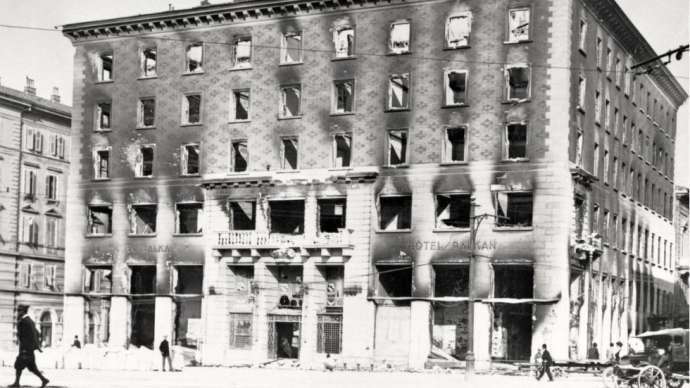STA, 13 July 2020 - National Hall, a Slovenian centre in the heart of Trieste, was formally handed over to the Slovenian minority in Italy, as a document on its ownership transfer was signed on Monday with Slovenian and Italian presidents Borut Pahor and Sergio Mattarella on hand exactly 100 years after the original building was burnt down by Fascists.
The document sets down a timeline of the full handover, which will take several years, as the centre currently hosts one of the Trieste University schools.
It was signed by representatives of Italian authorities at various levels, the university's chancellor and the heads of both minority organisations, the SSO and KGZS.
Slovenian and Italian politicians hailed it as a milestone for the Slovenian minority as well as Slovenia-Italy ties, but also for Europe, testifying to its values.
President Pahor labelled it a historic event and an act that happens once in a hundred years. "The injustice has been remedied, justice has been done," he said in his address.
"What we're witnessing today is the forbidden dream coming true." At least for a day and metaphorically, Trieste is the capital of the EU because it celebrates the finest of values which are the foundations of the EU, he said.
His Italian counterpart Mattarella said that history could not be erased and the hard experiences people had experienced in this area could not be forgotten.
"This is why the present and the future call us to act in a responsible manner," he said, adding he and Pahor took a major step towards a dialogue of two cultures.
Slovenian Trieste-born writer Boris Pahor, who witnessed the torching of National Hall as a seven-year old, attended the event and was on the occasion decorated with Slovenia and Italy's highest state orders.
President Pahor then visited National Hall, saying today's events can serve as an inspiration "for our common European home" and further encouragement of the co-existence between Slovenia and Italy. They are unprecedented in the history of both nations, signalling "a new era".
Apart from attending the National Hall restitution event, Pahor and Mattarella went to the town of Basovizza to lay wreaths at the memorials to Slovenian victims of Fascism and to Italian victims of post-WWII killings, and jointly meet representatives of the Slovenian and Italian minorities, in what is the first such meeting.
Slovenian Foreign Minister Anže Logar, who attended the National Hall event together with Minister for Slovenians Abroad Helena Jaklitsch, spoke of a new page in the common future of the two nations, not only in Trieste but also in the EU.
His ministry also took the opportunity to again urge Italy to adopt a report on Slovenian-Italian relations in 1880-1956 which a commission of Slovenian and Italian historians compiled in 2000, and to take its findings into account when interpreting the periods of history the report covers.
National Hall was build in 1904 by the prosperous Slovenians from the area of Trieste as a unique state-of-the-art centre of commerce and culture.
Members of Italian Fascist and nationalist groups set it to fire on 13 July 1920, burning it to the ground, and then attacked another 21 Slavic institutions in Trieste.
The arson severely affected the political situation in the region, fuelling ethnic hate between Italians and Slovenians. After the Fascists came to power in 1922, ethnic minorities, including the Slovenian one, became a target of severe assimilation.
The centre was later nationalised, the minority claimed it back, but Italy committed to return it only in the 2001 law on the safeguarding of the Slovenian minority.
The restitution event was more modest than planned due to Covid-19 and the main cultural event marking the centenary of the arson was rescheduled to 13 July 2021.
Meanwhile, at the memorials in Basovizza Pahor and Mattarella held hands while standing in front of them in sign of reconciliation.
The Memorial to Basovizza Heroes is a site of the execution of three Slovenians and one Croat whom the Fascist authorities killed in September 1930.
The men were members of an illegal organisation set up in 1927 to organise a fight against the Fascist regime and its violent assimilation policy.
The Foiba of Basovizza is meanwhile a Karst chasm which the Italians have chosen as their symbolic memorial site for the victims of post-war killings.
Italy believes the communists threw the executed Italians in it, whereas some historians say it has been proven empty.
Pahor's visit to the foiba memorial recently stirred controversy in Slovenia, with some fearing it would give the Italian revisionists of history a fresh impetus.
Some 150 protesters gathered at a border crossing to protest against Pahor's act and a group appeared at the Memorial to Basovizza Heroes after the commemoration, accusing Pahor of treason.
The head of the 13 July Not In My Name civil initiative, Mauro Dornik, said Pahor paid his respects at a chasm which historians proved was empty.
By doing so, he "confirmed that we are a genocidal nation which went about killing Italians just because they were Italians", not because they were Fascists, and thus sided with Fascists.
He said that Mattarella had not posthumously amnestied the Slovenian anti-Fascists killed in Basovizza, which proved both presidents' tribute to the Slovenian victims of Fascism was not sincere.
There was also some opposition to the restitution of National Hall on the Italian far-right, with the CasaPound movement staging a small protest in Trieste.






